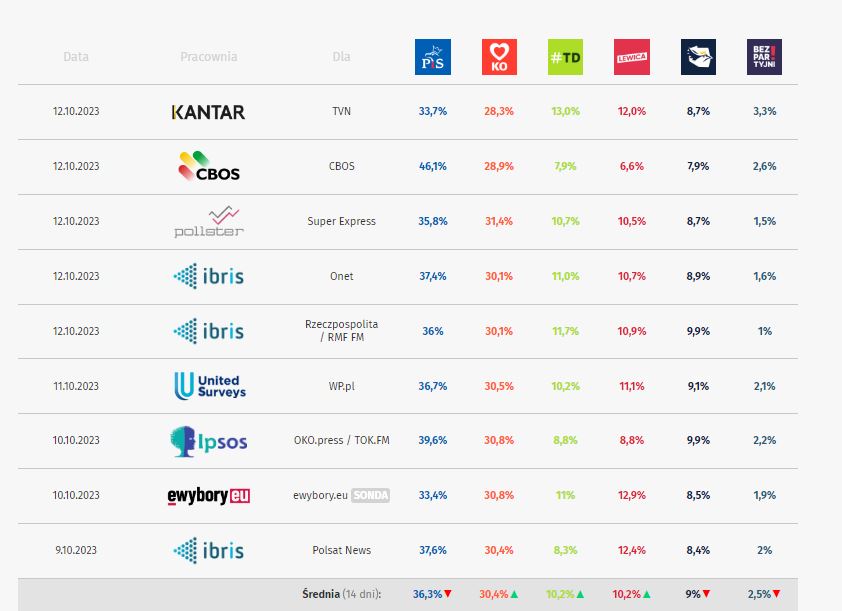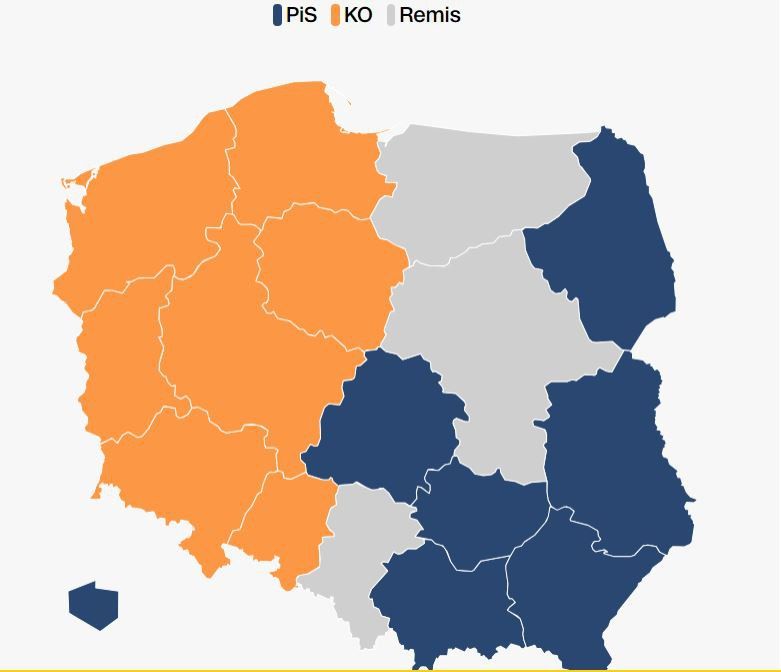On Sunday, October 15, polling stations opened in Poland, where voting for a new parliament will take place. Simultaneously with the parliamentary elections, a referendum is being held, which includes four questions: sale of state property to foreigners, raising the retirement age, the Polish-Belarusian wall and the admission of illegal immigrants from the Middle East and Africa
Оfficial voting in Poland started at 7 am (local time) and will last until 21:00. Poles elect 460 deputies and 100 senators for four-year terms. Of the country’s more than 29 million people eligible to vote, 12,792 vote by absentee ballot, and another 41,314 vote by proxy.
According to Rzeczpospolita, the official election results in Poland will be announced around noon on October 17. The publication also notes that the first exit poll data will be announced only after the polling stations close. It is noted that no interim results will be announced.
According to the latest polls, the ruling pro-presidential Law and Justice party has more support than any other party, but not enough to form a mono-majority in the new parliament. At the same time, analysts suggest that the most likely coalition will be formed between Law and Justice party and the far-right Confederation party. Also, Law and Justice party will theoretically be able to create a coalition with one of the parties of the Third Way bloc (the Polish Coalition of Wladyslaw Kosiniak-Kamysh, which includes the Polish People’s Party, Harmony, Center for Poland, Union of European Democrats “, “Silesians Together”, “Poland Fair Play”, as well as “Poland 2050” by Szymon Gołowni). Most likely, if it achieves success in the elections, Law and Justice party can attract to its side many individual deputies from the pro-European coalition.
At the same time, it is important to note that according to the results of recent polls, the three opposition forces (Civic Platform, Third Way and Left) have a slightly higher level of support than the current government, so they can together get a majority of seats in the new Seimas – 233 seats with a minimum majority of 231 seats. However, these same scenarios indicate that such a coalition will be extremely unstable and dependent on every deputy vote.
It is noteworthy that from the point of view of historical retrospect, in the event of another victory in the elections, the ruling Law and Justice party will become the first political force that managed to retain power for three electoral cycles. The liberal Civic Platform, which laid claim to a similar figure and formed the government in a coalition with the Polish Peasant Party from 2007 to 2015, missed a similar opportunity by losing the elections to Law and Justice party. At the same time, the last party in the history of Poland to rule the country for more than eight years was the Polish United Workers’ Party . As a result ended with a crushing defeat in the first partially free elections in June 1989.
Since Saturday, October 14, a “silence regime” has been introduced in Poland—neither poll results, campaigning, nor calls to vote for a particular party can be published. At the same time, the main sociological services released data on Friday evening.
Updated 14:00
Thus, one of Poland’s most authoritative sociological services, KANTAR, records the gap between the ruling party and the opposition at around 6%. About 34% are ready to vote for PiS, and 28% for the Civil Coalition. As can be seen from the table, approximately the same thing is recorded by other sociological structures; that is, in all surveys, there is a slight advantage of “Law and Justice”. It is worth noting that similar indicators have been recorded over the past months.

At the same time, a record turnout is expected at the elections, which could reach about 70% of voters. For comparison, in 2019, the turnout was 61.74%. Already, there is a record turnout at foreign sites – in Italy, Sweden, Great Britain, Spain, Latvia, and Hungary. Queues are also reported in the United States and the Netherlands. Since voting lists abroad are formed in advance and based on applications, the number of pre-registered voters was known even before the start of the elections. Their number in the above countries ranged from 15 to 160 thousand people.
According to the results of previous election campaigns, as well as indicators of preliminary sociological research, Poland is electorally divided into three main sectors – the west is traditionally associated with Germany and the EU, the east of the country votes for nationalists and conservative Catholics, and the central part and the capital support alternative parties or not declare their preferences publicly. It is this third sector that, according to opinion polls, appears as “undecided”.

On the eve of the elections, the most controversial constituencies were determined, where the results could depend on each vote. First of all, this is Warsaw and the north of Poland – Torun, Elblag and Olsztyn. There are pretty strong local government structures that sympathise with Donald Tusk (Civic Coalition) or are directly associated with him, as well as robust economic ties with the EU.
The remaining regions of Poland vote more consistently and, apparently, predictably. The main electorate of PiS is more aggressive voters living mainly in the eastern regions. These residents of rural areas are afraid of migrants and want to be protected from the actively broadcast threat from Russia. These voters demand protection of the domestic market from Ukrainian farm products and support the widespread idea that Donald Tusk is the politician who wants to divide Poland with the Russians, as in 1939. The ruling party supports these stereotypes in every possible way – before the elections, they aired a series in prime time for two months about how Tusk was almost the organiser and customer of the disaster in Smolensk, that he was the best friend of Vladimir Putin and Angela Merkel. The result of such propaganda will be known shortly.
At the same time, as of noon (local time), representatives of the National Election Commission gave a press conference where they spoke about the operational situation at the polling stations. Thus, three attempts to disrupt the elections were recorded, four cases of placing posters and 29 cases of campaigning during pre-election silence. However, it is not noted in which regions the offences were recorded. At the same time, the police reported registering 144 offences at polling stations.
Preliminary turnout for regional election commissions must be published at 17:00 local time.
Updated 19:00
As previously stated by the Polish authorities, no results of exit polls or other possible polls showing interim election results are published publicly. At the same time, at 12:00 (local time) the first turnout results were published, which amounted to 22.59%. This figure is based on data from more than 299,000 polling stations, but is not final. However, we can already say that the interim turnout is more than 4% higher than it was in the 2019 elections (18.14%).
It is noteworthy that the highest voter turnout is observed both in the East (Bialystok), where high support for Jaroslaw Kaczynski and Peace was previously recorded, and in the North-West (Szczecin), where voters are more supportive of Donald Tusk and the Civic Platform. At the same time, Warsaw, where the largest number of undecided voters is located, is not lagging behind in activity.
Interestingly, the lowest turnout is also observed in the North (Gdansk) and East (Lublin, Rzeszow). In fact, we are talking about those regions that PiS and the Civic Platform are counting on most.
Despite the absence of any statements from the political forces participating in the elections (the regime of silence in Poland has been maintained since Saturday), some analysts agree that if activity at the polling stations remains active, the election result will correspond to the results of preliminary opinion polls.
In this case, it is worth paying attention to the results of surveys conducted over the past year. Source: Politico):
At the same time, Western media are beginning to support Donald Tusk and his “Civic Platform”. Thus, The Washington Post published an article in which it accused Kaczynski’s political party that during his eight years of rule, conservatives exercised control over the courts and the media, introduced strict restrictions on abortion, and also infringed on LGBT rights and undermined the foundations of the European Union.
As of 17:00 (local time), the turnout for the elections was 57.54%, which automatically determines the elections as valid. At the same time, the highest activity is observed in the central, eastern regions and northwestern regions. In fact, it can be stated that the struggle between the main opponents is learning.
Updated 22:30
At 21:00 local time, most polling stations closed in Poland. At the same time, voters who queued before 21:00 still have the right to vote. However, it is already known that the turnout for the 2023 elections was 73%, which is the highest result since 1989
The leaders of the main parties have already made official appeals. Despite the attempt to demonstrate a festive mood both at the headquarters of PiS and at the headquarters of the Civic Coalition, according to preliminary exit polls, it can be stated that Kaczynski’s Law and Justice clearly did not achieve the desired result. However, Tusk’s “Civic Coalition” cannot claim to create a strong coalition with other parties.
Both Kaczynski and Tusk ended their first public speeches after the end of the elections with words of victory, but the finalization of the election results and the struggle to create a coalition still lie ahead.
Currently, preliminary exit polls show PiS winning with a score of 36.8%. In second place is the “Civil Coalition” – 31.6%. The top three is closed by the “Third Way” with a result of 13%.
According to the results of a survey by the sociological company “Ipsos”, mandates in the Seimas can be distributed as follows:
“Law and Justice” – 200,
“Civil Coalition” – 163,
“The Third Way” – 55,
“Left” – 30,


